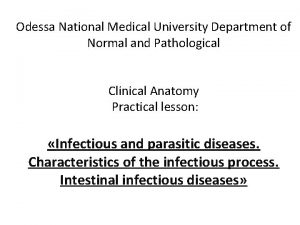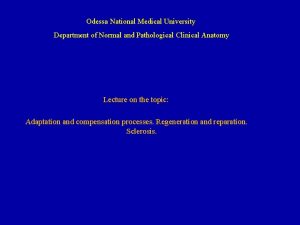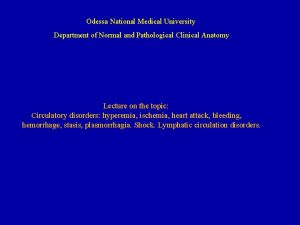Odessa National Medical University Department of Normal and













































- Slides: 45

Odessa National Medical University Department of Normal and Pathological Clinical Anatomy Practical lesson: «Diseases of the nervous system. Cerebrovascular disease»

List of questions for the practical lesson • • • • Classification of diseases of the nervous system? What are cerebrovascular diseases and their classification? What is intracranial hemorrhage and its types? What is Hemorrhagic Stroke? Ischemic stroke classification? What is hydrocephalus and its types? What is Alzheimer's Disease? What is amyotrophic lateral sclerosis? What is multiple sclerosis? What is encephalitis? Classification of encephalitis by etiology? Prevalence classification? Localization classification? Types of purulent (pyogenic) infections? Types of non-suppurative infections? Classification of tumors?

Classification of diseases of the nervous system? • • Vascular diseases Traumatic lesions Degenerative diseases Demyelinating diseases Neuropathies Infectious diseases Tumors Malformations of the nervous system

What are cerebrovascular diseases and their classification? They are characterized by acute disorders of cerebral circulation, the background for which is atherosclerosis and hypertension. These include: • Diseases associated with ischemic injury • Intracranial hemorrhage • Hypertensive cerebrovascular diseases

What is intracranial hemorrhage and its types? Most common: • Intracerebral hemorrhage with hypertension (hemorrhagic stroke) • Subarachnoid hemorrhage with ruptured arterial aneurysm

What is Hemorrhagic Stroke? • Many intracranial hematomas are formed due to rupture of microaneurysms or vascular malformations • The hemorrhagic component occurs due to diapedesis in the demarcation zone

Macropreparation Hemorrhage in the area of the basal ganglia in hypertension.

Macropreparation Hemorrhagic cerebral infarction caused by arterial embolism. Edema is pronounced. A noticeable decrease in the size of the ventricle on the left side

Macropreparation Subarachnoid hemorrhage from a ruptured aneurysm. The mortality rate is 25 to 50%

Macropreparation Diffuse subarachnoid hemorrhage extends from the base of the brain to the lateral surface of the frontal and temporal lobes

Ischemic stroke classification? • Ischemic infarction (white) • Hemorrhagic infarction (red) • The basin of the middle cerebral artery is most often affected. The most common reasons: • thromboembolism in the vessels of the brain; • thrombosis and stenosing atherosclerosis of the cerebral arteries; • inflammatory lesion of the arterial network of the brain

Macropreparation Lesion of the middle cerebral artery with subsequent gray softening of the brain

Micropreparation Many macrophages are seen on the right, destroying lipid residues of colliquation necrosis

Micropreparation The defeat of Purkinje cells between the molecular and granular layers of the cerebellum, sensitive to anoxia - fuzzy cytoplasmic boundaries, karyolysis

What is hydrocephalus and its types? This is an excessive accumulation of cerebrospinal fluid in the cranial cavity, which occurs in the following variants. Internal hydrocephalus - increased volumes of cerebrospinal fluid in the ventricular system with their expansion - the most common form of hydrocephalus; External hydrocephalus is the accumulation of excess cerebrospinal fluid in the subarachnoid space. Divided by: • open (preserved outflow of cerebrospinal fluid from the ventricular system into the subarachnoid space) • occlusive (closed) form (the outflow of cerebrospinal fluid from the ventricular system into the subarachnoid space is impaired).

What is Alzheimer's Disease? Ø Degenerative disease in which presenile (pre-senile) dementia develops, intellectual disorders and emotional lability are expressed Ø A relationship with senile cerebral amyloidosis was revealed - the formation of plaques in the vessels of the brain, membranes, choroid plexuses Ø Atrophy of the cerebral cortex in the frontal, parietal, occipital lobes, hydrocephalus often develops

Macropreparation Brain in Alzheimer's disease. Atrophy is manifested by narrowing of the convolutions and widening of the furrows in the frontal and parietal lobes

Macropreparation More pronounced atrophy in Alzheimer's disease, visible from above and laterally

Micropreparation Senile plaques in the brain tissue

Micropreparation Accumulation of amyloid in brain tissue and vascular wall

Micropreparation Neurofibrils in Alzheimer's disease. CNS cell prolapse

What is amyotrophic lateral sclerosis? Progressive disease of the nervous system associated with the simultaneous damage to motor neurons of the anterior and lateral columns of the spinal cord and peripheral neurons • Selective atrophy of the anterior motor roots of the spinal cord, the posterior ones are not affected • Nerve cells are shriveled, large fields of neuronal prolapse are visible • In nerve fibers - demyelination, uneven swelling, decay and death of axial cylinders

Macroscopically, on transverse sections of the spinal cord with amyotrophic lateral sclerosis, pale coloration of the corticospinal tracts caused by degeneration is noticeable

Micropreparation Atrophy of the lateral columns of the spinal cord with gliosis in amyotrophic lateral sclerosis

What is multiple sclerosis? Demyelinating chronic disease, which is characterized by the formation in the brain and spinal cord (white matter) of disseminated foci of sclerosis - plaques. Due to the multiple localization of foci, the clinical manifestations are different. Ø At an early stage - foci of demyelination around vessels, especially veins and venules - perivenous demyelination Ø At a later stage, small foci merge, demyelinize, proliferates from microglial cells appear, and at the end typical plaques form, in which oligodendrocytes are absent.

A large gray-brown demyelinating "plaque" is visible in the white matter - typical of multiple sclerosis.

Demyelinated plaque in a patient with multiple sclerosis

What is encephalitis? Encephalitis (from the Greek. enkephalon - brain) is an inflammation of the brain associated with infection, intoxication or injury. Infectious encephalitis can be caused by viruses, bacteria, fungi, but the most important among them are viral encephalitis.

Classification of encephalitis by etiology? I. Primary encephalitis (independent diseases) A) viral: - arbovirus: tick-borne spring-summer, mosquito, etc. viral multi-season: enterovirus Coxsackie and ESNO, etc. - caused by an unknown virus: epidemic (economo). B) microbial and rekettsialny: with neurosyphilis, with typhus. II. Secondary encephalitis: - viral: with measles, with chickenpox, with rubella; - post-vaccination (DPT, smallpox, rabies); - microbial and rekettsialny: staphylococcal, streptococcal, malarial, toxoplasmic. - encephalitis and encephalomyelitis of infectious-allergic and allergic genesis. III. Encephalitis due to slow infections - demyelinating - subacute sclerosing panencephalitis.

Prevalence classification? - leukoencephalitis - polyencephalitis - panencephalitis

Localization classification? - stem - cerebellar - mesencephalic - diencephalic

Types of purulent (pyogenic) infections? Inflammation of the meninges – meningitis. 1. when localized in the dura mater - pachymeningitis, 2. in the soft (vascular) and arachnoid membranes leptomeningitis, occur most often.

Types of non-suppurative infections? Tuberculosis. Two main forms of tuberculous infection are realized in the brain: tuberculous meningitis and tuberculoma. § Tuberculous meningitis. In tuberculous meningitis, the hematogenous spread of the pathogen dominates as a component of miliary seeding or as a result of spread from the tuberculous focus. § Tuberculoma. This is an encapsulated focus of caseous necrosis. In adults, tuberculoma is localized in the cerebral hemispheres, and in children, most often in the cerebellum. Syphilis. The causative agent of this sexually transmitted disease is Treponema pallidum. It has 2 main forms - tertiary and parenchymal (quaternary) neurosyphilis. § Tertiary neurosyphilis. It is characterized by subacute meningitis. § Parenchymal neurosyphilis. The developing subacute encephalitis is accompanied by progressive paralysis, mental disorders and progressive dementia.

Classification of tumors? • • • astrocytic (50%) oligodendroglial (5%) ependymar (6%) embryonic neuroectodermal growing into the cranial cavity various

Micropreparation Astrocytoma

Micropreparation. Oligodendroglioma

Macropreparation. Ependymoma

Micropreparation. Ependymoma

Micropreparation. Papillary ependymoma

Micropreparation. Medulloblastoma

Micropreparation. Glioblastoma

Micropreparation. Meningioma

Macropreparation. Meningioma

Micropreparation. Meningioma

Micropreparation. Traumatic neuroma
 Odessa state environmental university
Odessa state environmental university Odessa state environmental university
Odessa state environmental university Cities in the north central plains of texas
Cities in the north central plains of texas Oc tech odessa tx
Oc tech odessa tx Coding bootcamp odessa
Coding bootcamp odessa Kiev odessa
Kiev odessa Brenntag great lakes chicago
Brenntag great lakes chicago Jobsindice.com odessa tx
Jobsindice.com odessa tx Odessa commercial sea port
Odessa commercial sea port M.gorky donetsk national medical university
M.gorky donetsk national medical university Seoul national university medical school
Seoul national university medical school Mongolian national university of medical sciences
Mongolian national university of medical sciences Medical education and drugs department
Medical education and drugs department National risk ambulance
National risk ambulance Difference between medical report and medical certificate
Difference between medical report and medical certificate Tracer card medical record
Tracer card medical record Hymen
Hymen National core standards domains
National core standards domains National audit department
National audit department Serum vs plasma
Serum vs plasma National unification and the national state
National unification and the national state Department of law university of jammu
Department of law university of jammu Department of geology university of dhaka
Department of geology university of dhaka Mechanicistic
Mechanicistic University of bridgeport it department
University of bridgeport it department University of iowa math
University of iowa math Sputonik
Sputonik Psychology texas state
Psychology texas state Department of information engineering university of padova
Department of information engineering university of padova Information engineering padova
Information engineering padova Manipal university chemistry department
Manipal university chemistry department Syracuse university psychology department
Syracuse university psychology department Jackson state university finance department
Jackson state university finance department Webnis
Webnis Michigan state university physics
Michigan state university physics Columbia university cs department
Columbia university cs department University of sargodha engineering department
University of sargodha engineering department Claudia arrighi
Claudia arrighi Normal gait medical term
Normal gait medical term Medical term for normal gait
Medical term for normal gait Erect position medical terminology
Erect position medical terminology Kyiv national university of culture and arts
Kyiv national university of culture and arts National and kapodistrian university of athens events
National and kapodistrian university of athens events National yunlin university of science and technology
National yunlin university of science and technology Doctors license number
Doctors license number Gbmc infoweb
Gbmc infoweb




































































